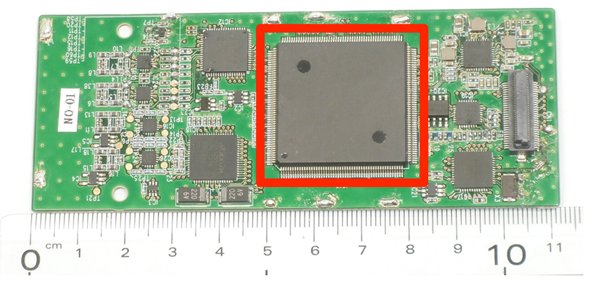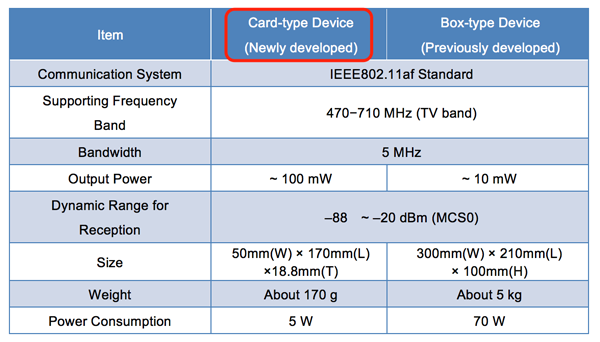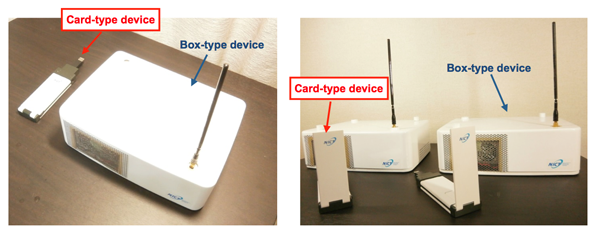National Institute of Information and Communications Technology
Home > Press Release > NICT Develops World's First IEEE802.11af-compatible Baseband IC for TV White-space Wireless LAN Systems
NICT Develops World's First IEEE802.11af-compatible Baseband IC for TV White-space Wireless LAN Systems
- Downsized device driven by USB power realized at low cost, 1/10 of level of previous gear -
December 16, 2015
- Developed world’s first baseband IC for TV white-space WLAN system based on IEEE802.11af standard.
- Prototyped small size communication device measuring 1/30 of size and weight, and consuming 1/15 of power in comparison with previous devices.
- Makes commercial deployment easy for white-space WLAN systems by cost-reduction to 1/10 or less.
NICT has successfully developed the world’s first baseband IC applicable to TV white-space wireless LAN (WLAN) systems. This prototype IC conforms to IEEE802.11af that is the international standard of the WLAN system in the TV white-space spectrum. In addition, NICT has successfully prototyped a card-type communication device in an all-in-one package including an antenna. This card-type device can be driven by USB power and operated by inserting it to the USB port of an off-the-shelf PC. The prototype IC contributes to substantial size and cost reductions for communication devices and enables easy implementation in/with other communication devices as a general component, and thus commercial deployment of a TV white-space WLAN system is expected at low cost.
Background
From the viewpoint of effective use of limited spectrum resources, TV white-space (TVWS) utilization has been studied in various countries and regions due to its superior radiowave propagation characteristics. NICT has also contributed to the standardization of IEEE802.11af that defines specifications of WLAN systems in the TV band. Furthermore, NICT has developed box-type communication devices based on the IEEE802.11af standard and has been taking the lead to demonstrate the practicality of the TVWS communication technology.
On the other hand, the same convenience and simplicity as the traditional Wi-Fi system are required for commercial deployment, and thus communication devices small in size and low in power consumption are strongly required as well as easy installation.
Achievements

Figure 1 Developed baseband IC and its mounting board for TV white-space WLAN system.

Figure 2 Prototyped card-type communication device by implementation of the baseband IC.
NICT has successfully developed a baseband IC based on the IEEE802.11af standard (Figure 1). By replacing the FPGA for baseband signal processing with the new IC, it becomes easier to prototype downsized communication devices with low power consumption. In addition, it becomes easy to implement the IC in/with other communication devices as a general component. Further cost reduction is also expected for contribution to the commercial deployment of the white-space WLAN technology.
Furthermore, NICT has successfully prototyped card-type communication devices small in size and low in power consumption at low cost (Figure 2). This card-type device meets the BPSK and QPSK specifications of IEEE802.11af, enabling a maximum communication speed of about 2.6Mbps by using two units of the device. Other main features of this prototype are as follows.
(1) By installing the baseband IC, downsizing to 1/40, weight reduction to 1/30 and power-saving to 1/15 are achieved in comparison with previously developed box-type devices. The prototyping expense is also reduced to less than 1/10.
(2) This device has a USB interface as well as the common card-type communication devices, and can be operated by USB power.
(3) Available in a simple, all-in-one package including an antenna.
(4) This device can be operated in both access point and station modes. By using multiple devices, it is easy to deploy a network of white-space WLAN systems.
These features enable easy installation in any location where user traffic is congested for effective load-balancing. In addition, superior propagation characteristics of the TV band have the potential to establish communication infrastructure in some regions with difficulties in the deployment of wired networks and to reduce the number of devices in comparison with conventional wireless networks.
Future perspectives
The prototyped baseband IC contributes to not only downsizing and power-saving of devices but also cost reduction for the production and enables easy deployment of communication infrastructure in some regions with difficulties in the deployment of wired networks. In this manner, utilization of white-spaces is not merely for the effective use of limited spectrum resource but also for solving social problems such as digital divide.
NICT also aims to further social implementation of this achievement in combination with previously developed white-space technologies.
Previous press releases from NICT related to TV White Space technologies
- Wireless communication in TV white space succeeded
- By using database to provide available channels, enabling traffic off-load -
June 7, 2012 - World’s First Breakthrough Achieved for Long-Range Broadband Communications in TV White Space
January 23, 2014 - Trials of TV White Space Communications at 40Mbps in Central London
- With Qualified White Space Database under UK Ofcom Pilot -
July 24, 2014
Appendix
Prototyped card-type communication device by implementation of the IEEE802.11af compatible baseband IC
Figure 1 shows the developed baseband IC and its mounting board. This baseband IC conforms to the IEEE802.11af standard that is the international standard of the WLAN system in the TV white-space spectrum.

Figure 1 Developed baseband IC and its mounting board for TV white-space WLAN system.
Figure 2 shows the developed card-type communication device in which the baseband IC is implemented. All the devices and components such as the baseband IC, an RF IC and an antenna are assembled in all-in-one package to reduce the device size.

Figure 2 Prototyped card-type communication device by implementation of the baseband IC.
Table 1 shows specifications of the card-type communication device in comparison with the box-type communication device that was previously developed in NICT. By replacing the FPGA for baseband signal processing with the new IC, downsizing to 1/40, weight reduction to 1/30 and power-saving to 1/15 have been achieved. This prototype meets the BPSK and QPSK specifications of IEEE802.11af, enabling a maximum communication speed of about 2.6Mbps by using two units of the device.
Table 1 Specifications of the newly and previously developed devices.

Figure 3 compares the appearance between card-type and box-type communication devices. The total size of the card-type is substantially reduced in comparison with the box-type, even when an antenna part is raised in use. Furthermore, by reducing power consumption, the card-type communication device can be driven by USB power and simply used by inserting it to the USB port of an off-the-shelf PC. By adopting a common USB interface, convenience and simplicity have been also achieved. The prototyping expense of the card-type device is also remarkably reduced to 1/10 or less.
In addition, since this card-type communication device can be used in both access point and station modes, it is easy to deploy a network of white-space WLAN systems by using multiple deices. Besides, reduction of the installation number of access points is expected in the existing wireless networks due to its relatively wide coverage area, enabling coverage of a whole house or a wide conference room with one access point, for example.

Figure 3 Appearance of the card-type and box-type communication devices.
Technical Contact
Takeshi Matsumura, Kentaro Ishizu and Fumihide Kojima
Smart Wireless Laboratory
Wireless Network Research Institute
Tel: +81-46-847-5076
E-mail: 


































Media Contact
Sachiko Hirota
Public Relations Department
Tel: +81-42-327-6923
E-mail: 


























